The Peak district (3 days- 100 miles)
Day 1- Buxton- Monsal trail- Matlock- High Peak Trail- Buxton (47 miles)
We planned this ride for six months and by the time we were due to go, it was mid-summer and absolutely boiling hot. We intended to spend two days at Buxton using this as the base to explore the area, on the second day we were going to ride to my mates house in Little Haywood near Stafford, stay the night and ride on to Stafford in the morning to catch the train home. To get to Buxton, we had to change trains at Stockport, and I found the oddest thing when booking the tickets. I often try to split the journey up, in order to find cheaper alternatives. It was cheaper to go to all the way to Buxton than book a single journey to the nearer Stockport.
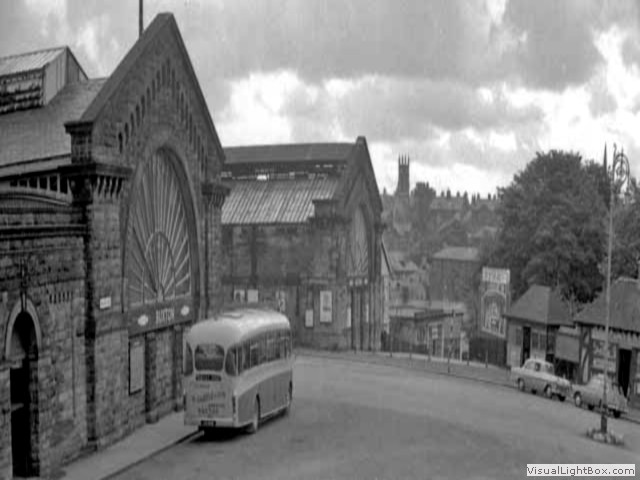 The journey was pleasant climbing through the Peak District. Buxton was once a popular
Victorian resort and of course the station would have been their first sight of the
town. Today the Victorian station had lost its grandiose appearance; the only structure left was a
single arch in the gable end. The train journey to Buxton was around five hours long, so we decided to
stay an extra night and make a start in the morning. After such a long journey we wanted a cup of
tea, we headed for the Pavilion Park, past the Opera House. From here we rode to our digs; Staden
Grange hotel. Buxton hotels are overly expensive, Staden Grange hotel was the cheapest I could get, but
was a mile or two out of town. We were in the converted stables annex, which was very comfortable. There
is a bar at the hotel but only bottled beer is sold and no food. The hotel can also accommodate campers and caravans
in a large grassy wooded area, with fantastic views. In the evening, we ordered a taxi into town
and went to Wetherspoons; the Wye Bridge House. It was steak night I believe we had a mixed
grill and a pint, for under eleven pound. The Wye bridge house is positioned next to the
fantastic massive viaduct.
The journey was pleasant climbing through the Peak District. Buxton was once a popular
Victorian resort and of course the station would have been their first sight of the
town. Today the Victorian station had lost its grandiose appearance; the only structure left was a
single arch in the gable end. The train journey to Buxton was around five hours long, so we decided to
stay an extra night and make a start in the morning. After such a long journey we wanted a cup of
tea, we headed for the Pavilion Park, past the Opera House. From here we rode to our digs; Staden
Grange hotel. Buxton hotels are overly expensive, Staden Grange hotel was the cheapest I could get, but
was a mile or two out of town. We were in the converted stables annex, which was very comfortable. There
is a bar at the hotel but only bottled beer is sold and no food. The hotel can also accommodate campers and caravans
in a large grassy wooded area, with fantastic views. In the evening, we ordered a taxi into town
and went to Wetherspoons; the Wye Bridge House. It was steak night I believe we had a mixed
grill and a pint, for under eleven pound. The Wye bridge house is positioned next to the
fantastic massive viaduct.
The first proper day of riding was to be along the Monsal trail with four navigable tunnels, now fully open. The ride was made popular by the TV program; ‘Julia Bradbury's Railway Walks’, though. when she did the walk, the tunnels were not open. Buxton has an iconic railway viaduct at the one end of the town, but it still carries an active goods railway, so the start of the trail is about 3 miles out of town. We followed the A6 for a while alongside the River Wye, then climbed up some steps and on to the path, a good tarmac surface. From this point the trail follows the River Wye eastward above the side of the valley as it cuts through a central plateau of carboniferous limestone. It wasn't long before the scenery opened up and we were heading towards the first of the tunnels. We entered Chee Tor tunnel number two, which is only 100 yards long coming out onto a small viaduct and then back into Chee Tor tunnel number one. We emerged into the daylight and we were on another viaduct with loads of kids abseiling off the side.
The path now split into two but both ended up in the same place; Millers Dale station, whats left of the station building is unimpressive, but the line was so popular in Victorian times, they had to build a second bridge across the River Wye to meet demand. Strangely, the older of the two bridges is the one open to the public. East of Miller’s Dale station there are some interesting examples of 19th century commercial limekilns. The Valley below had a large history of manufacturing mills as Litton mill can be seen down the valley on the left, as Litton tunnel opened up before us. On the other side of the tunnel in the valley, Cres Brook Mill could now be seen. Most of these mills have now been converted to expensive residential flats.
 We entered the current easternmost tunnel; Headstone. Its outstanding approach cutting, has
near-vertical sides supported with masonry or brick pillars. People are protected from loose material
and falling rocks by a steel-framed canopy inserted into the tunnel entrance, it is currently the
longest one open on the trail. Be prepared for the sudden drop in temperature, even in mid summer.
At Great Longstone station there was an interesting legacy from the Victorian middle class. The owner
of Thornbridge hall built his own station next to Longstone station so he didn't have to mix with the
peasants. The last accessible station on this line is Bakewell, again the main station building has
gone and what’s left on the left side is now a private residence and B&B. It's better seen from
the other side. Bakewell town is probably a mile or two away from the station and can be seen below
us. This must be one of the most popular routes I’ve been on, only lasting
nine miles.
We entered the current easternmost tunnel; Headstone. Its outstanding approach cutting, has
near-vertical sides supported with masonry or brick pillars. People are protected from loose material
and falling rocks by a steel-framed canopy inserted into the tunnel entrance, it is currently the
longest one open on the trail. Be prepared for the sudden drop in temperature, even in mid summer.
At Great Longstone station there was an interesting legacy from the Victorian middle class. The owner
of Thornbridge hall built his own station next to Longstone station so he didn't have to mix with the
peasants. The last accessible station on this line is Bakewell, again the main station building has
gone and what’s left on the left side is now a private residence and B&B. It's better seen from
the other side. Bakewell town is probably a mile or two away from the station and can be seen below
us. This must be one of the most popular routes I’ve been on, only lasting
nine miles.
We leave the Monsal trail just after Bakewell station as Hadden tunnel remains closed, hopefully in
the future they will reopen this and the track will go all the way to Rowsley. From here we
rode along very small lanes all the way to Matlock, once there, the familiar sound
of a steam train could be heard. We headed for Matlock station home of the heritage railway; Peak
rail. It was about twenty two miles to here and the sun was beaming down, so we had a cup of tea at
Matlock station. Then we rode along the busy A6 which closely followed the pretty River
Derwent, overhead there was a cable car climbing up the top of the hill. We headed towards
high peak junction where the Cromford canal meets the High Peak Railway.
 There's a few preserved buildings from the era, then the path crosses under the main road and climbs up a
steep incline. Only the trucks went up and down these inclines, powered by static steam
engines using a steel rope to tow the trucks. This was split into two sections and the remains
of the second engine house building remains at the top off Middleton incline. The high peaks
trail carries on climbing, naturally showing off the fantastic views of the Peak District.
At its conclusion the high peaks trail merges with the Tissington Trail, we rode the Tissington
trail back to Buxton. I thought I would leave the commentary on the Tissington Trail for
day two. After a hot day in the saddle we bought a few beers and groceries in a local shop and
took them back Staden Grange, where we had a barbecue, it was very pleasant.
There's a few preserved buildings from the era, then the path crosses under the main road and climbs up a
steep incline. Only the trucks went up and down these inclines, powered by static steam
engines using a steel rope to tow the trucks. This was split into two sections and the remains
of the second engine house building remains at the top off Middleton incline. The high peaks
trail carries on climbing, naturally showing off the fantastic views of the Peak District.
At its conclusion the high peaks trail merges with the Tissington Trail, we rode the Tissington
trail back to Buxton. I thought I would leave the commentary on the Tissington Trail for
day two. After a hot day in the saddle we bought a few beers and groceries in a local shop and
took them back Staden Grange, where we had a barbecue, it was very pleasant.
Day 2- Buxton- Tissington Trail- Little Haywood (44 miles)
Today we were leaving Buxton and travelling to Little Haywood along the Tissington trail. The trail is a few miles out of town along the busy A515 road. The signage is very poor with only a bus stop to indicate where to turn off the main road. You go two hundred yards down a bumpy farm track lane and turn left, this is where the trail starts proper. To the right there are buffers where the quarry branch line ends, hopefully when the quarry eventually shuts the path should go all the way in to Buxton. The trail has a fine white gravel packed down to make it rideable. The first notable place is Parsley Hay station which has now been converted into a café, cycle hire, and a repair shop. From here, hoards of kids were setting off along the trail.
Just after Parsley Hay station the trail splits into two, left is the High Peaks trail, but we were going right today on the Tissington trail. We came to a deep cutting with colourful wild flowers spread along the verges. After this, the scenery now opens up and is the inspiration for the ‘Rambling Fat man’ web page design, rolling hills and trees illuminated by the sun, with the track heading downhill. We came across Hartington signal box, the restored signal box seems to be in the middle of nowhere. Most of the kids had now disappeared as we were too far out, but it wasn't long before they began to reappear again as we neared Tissington station.
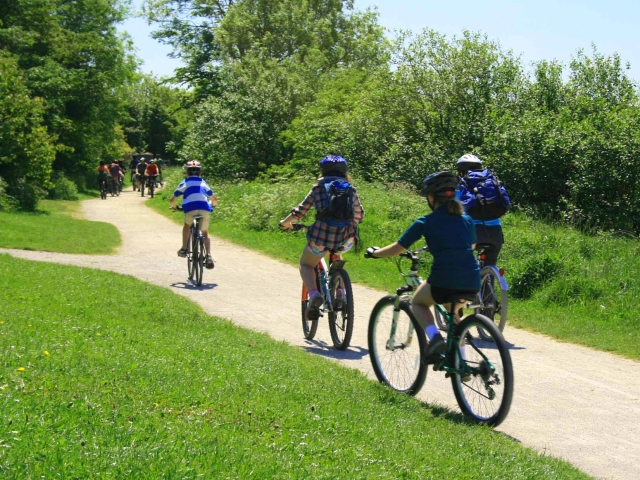 At Tissington station, we had a welcome break. The station is converted into a cafe and
cycle hire like Parsley Hay station, these two places are where most people set off, but they
turn around about half way and ride back. We set off again and barley survived an assault by a
marauding gang of eight year old cyclists, we reset the hands on the brakes and continued, the trail now
becomes quite woody as we approach Ashbourne. The last rideable piece the trail is through
Ashbourne tunnel, which opens up into a car park. The car Park was the site of Ashbourne
station, but nothing is left except the Station Hotel across the road.
At Tissington station, we had a welcome break. The station is converted into a cafe and
cycle hire like Parsley Hay station, these two places are where most people set off, but they
turn around about half way and ride back. We set off again and barley survived an assault by a
marauding gang of eight year old cyclists, we reset the hands on the brakes and continued, the trail now
becomes quite woody as we approach Ashbourne. The last rideable piece the trail is through
Ashbourne tunnel, which opens up into a car park. The car Park was the site of Ashbourne
station, but nothing is left except the Station Hotel across the road.
The line did continue with three more stations before joining the main line at Uttoxeter. The first of those stations is Clifton, near Cock Hill. You would hardly recognize the station as it has been converted into a residential house and has been painted white. We turned into Sides Lane which follows the River to Dove, a very pretty and peaceful road. The Sun was beating down, it was too hot for cycling helmets, so we wore sun hats. At Norbury there was another station and a fantastic church. Norbury church served the nearby Manor house and I guess so did the station because there is nothing else around. Only the station master's house remains. We crossed the River Dove and rode quite close to the river bank.
Rocester was the site of the next station on the old line, this has totally disappeared and is now the site of the JCB factory. It has a lake and nature reserve setup by JCB. We still had a few miles to go, so continued on. At Weston, we jumped onto the Trent and Mersey canal all the way to Little Haywood, some of the path is rough, and I imagine it is quite muddy in the winter. We had ridden forty three miles today in the blazing sun and were eager to have a shower and a pint. The Clifford Arms was a short walk from my mates house, we had just one pint here and then walked to the Lock House restaurant for food. The Lock House resides on the side of the canal, barges chugged past while we ate our home cooked food. A long day but good fun.
Day 3- Little Haywood- Stafford (8 miles)
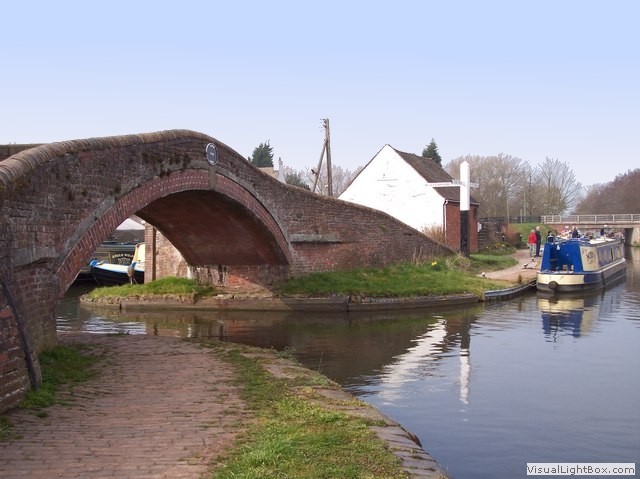 We set off from little Haywood on the Trent and Mersey canal. At Great Haywood junction the canal
joins the Staffordshire and Worcestershire canal, there’s a boat yard and a cafe here. The path isn’t
the best to ride on, there are parts where walkers have carved a path only a foot wide. Built in the 1770’s
Tixall lock complex has a pretty lock keepers cottage. With two rivers around here; the River Trent
and the River Sow, one has to wonder why the canals were built. We crossed the River Sow on a small
aquaduct then followed it on the right side, on the other side of us was the main west coast railway line,
until we passed underneath it. Now the canal followed the River Penk (a very strange name). Near most of the
bridges the path changed to cobble stones, I suppose to help horses with the grip, but generally the
paths were poor.
We set off from little Haywood on the Trent and Mersey canal. At Great Haywood junction the canal
joins the Staffordshire and Worcestershire canal, there’s a boat yard and a cafe here. The path isn’t
the best to ride on, there are parts where walkers have carved a path only a foot wide. Built in the 1770’s
Tixall lock complex has a pretty lock keepers cottage. With two rivers around here; the River Trent
and the River Sow, one has to wonder why the canals were built. We crossed the River Sow on a small
aquaduct then followed it on the right side, on the other side of us was the main west coast railway line,
until we passed underneath it. Now the canal followed the River Penk (a very strange name). Near most of the
bridges the path changed to cobble stones, I suppose to help horses with the grip, but generally the
paths were poor.
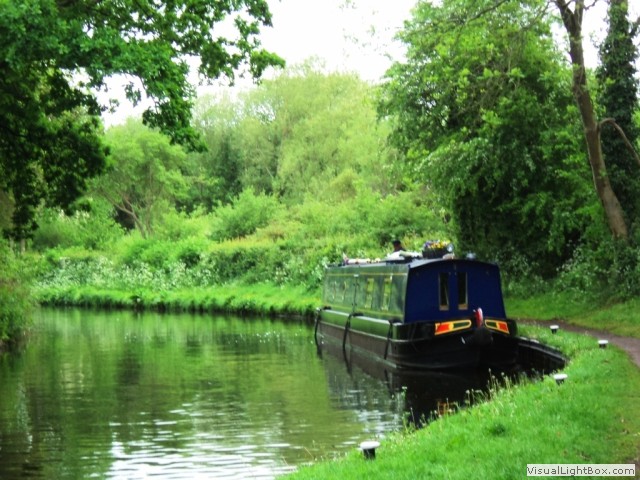 At Baswich the path was quite dodgy, there seemed to be intermittent shards of sharp stone sticking
up reducing our speed. Shortly after this we turned off the canal onto, what is best described as an
elevated walkway across some marshland. We crossed the River sow again then turned left along the River
Sow. The River Sow path is much better and takes us most of the way into the centre of Stafford, there we
headed for Victoria park to while away an hour. The River Sow runs right through the park and makes a pretty
addition to the flowers in the park.
At Baswich the path was quite dodgy, there seemed to be intermittent shards of sharp stone sticking
up reducing our speed. Shortly after this we turned off the canal onto, what is best described as an
elevated walkway across some marshland. We crossed the River sow again then turned left along the River
Sow. The River Sow path is much better and takes us most of the way into the centre of Stafford, there we
headed for Victoria park to while away an hour. The River Sow runs right through the park and makes a pretty
addition to the flowers in the park.
Depending on where you read it, the trails around Buxton are rated in the top ten rides in the UK, for their ease of riding and the scenery around them. At 28°C, we were told by a taxi driver that this is unprecedented exceptionally good weather for Buxton, leading to a cracking few days. Due to Buxton’s relatively high elevation, it tends to be cooler than surrounding towns, with daytime temperature typically 2°C lower than Manchester. Every month Buxton receives more rainfall than the UK average. Extensions to the Monsal Trail from Bakewell to Matlock are in the planning process making a sixty mile loop, when they’re finished, I’ll do it again. Good memories.
-
Gallery
 Why not have
a look at the gallery relating to day 1 of this ride. Click the image or the title.
Why not have
a look at the gallery relating to day 1 of this ride. Click the image or the title. -
Haunted Old Hall hotel
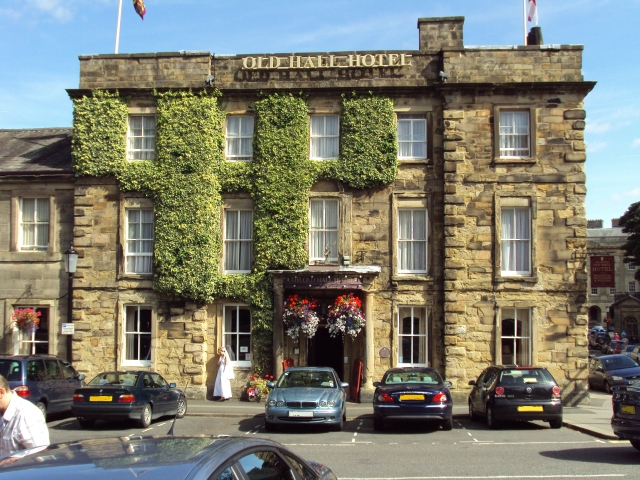 Built in 1674 by the Earl of Shrewsbury on the sanction of Queen Elizabeth 1st to provide accommodation
for Mary Queen of Scots during her house arrest, the Old Hall is thought to be England’s oldest
hotel. Unusually this hotel was built over a hot spring that is currently beneath the eastern end of
the hotel, this hot spot was an important sacred shrine for Celtic travelers and became a popular bath
for the Roman settlement “Aqua Arnemetia”.
Built in 1674 by the Earl of Shrewsbury on the sanction of Queen Elizabeth 1st to provide accommodation
for Mary Queen of Scots during her house arrest, the Old Hall is thought to be England’s oldest
hotel. Unusually this hotel was built over a hot spring that is currently beneath the eastern end of
the hotel, this hot spot was an important sacred shrine for Celtic travelers and became a popular bath
for the Roman settlement “Aqua Arnemetia”.
 Mary Queen of Scots was executed in 1587, on her last visit to the old hall, she carved a message
on the window in Room 26, “Buston, whose warm waters have made thy name famous, perchance I shall
visit thee no more—Farewell.” Many guests who have visited room 26 have reported the presence of
Mary and believe they feel her while staying in the room. Even creepier is the fact that the
inscription can still be seen in the room.
Mary Queen of Scots was executed in 1587, on her last visit to the old hall, she carved a message
on the window in Room 26, “Buston, whose warm waters have made thy name famous, perchance I shall
visit thee no more—Farewell.” Many guests who have visited room 26 have reported the presence of
Mary and believe they feel her while staying in the room. Even creepier is the fact that the
inscription can still be seen in the room. -
Cruel Litton Mill
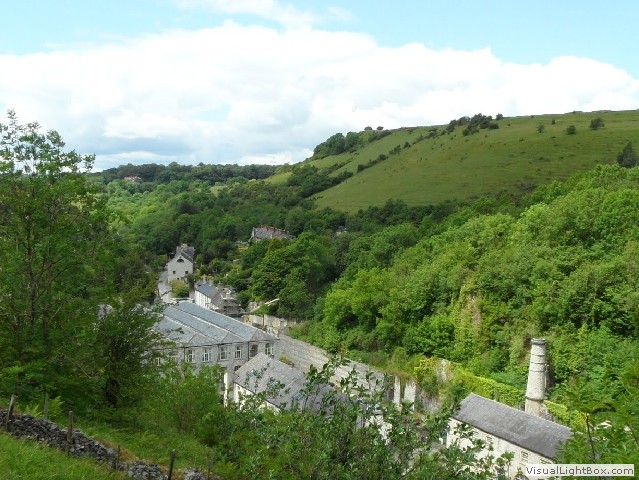 Litton Mill was opened in 1782 and became notorious for the harsh and abusive treatment of its employees. The owner,
Ellis Needham meted out punishment to the child labourers brought in from London and other big cities to fuel the
wheels of industry. Overall, child labour was crucial to the development of the cotton mills, but there
was very little legal protection for the children. This cruel exploitation caused the deaths of many
kids, some as young as nine or ten, as their graves in Tideswell and Taddington churchyards will
testify. The testimony of one of the children at the mill helped change the law to improve conditions
and ban minors working under a certain age.
Litton Mill was opened in 1782 and became notorious for the harsh and abusive treatment of its employees. The owner,
Ellis Needham meted out punishment to the child labourers brought in from London and other big cities to fuel the
wheels of industry. Overall, child labour was crucial to the development of the cotton mills, but there
was very little legal protection for the children. This cruel exploitation caused the deaths of many
kids, some as young as nine or ten, as their graves in Tideswell and Taddington churchyards will
testify. The testimony of one of the children at the mill helped change the law to improve conditions
and ban minors working under a certain age. -
Victorian Navvies
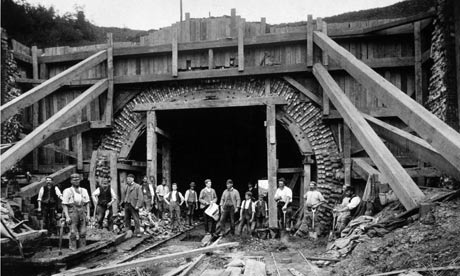 Engineers may have designed the railways, but it was left to vast gangs of navvies to build them. The
word ‘navvy’ came from the ‘navigators’ who built the first ‘navigation canals’ in the eighteenth
century. They lived by the rail line that they were building in so-called shanty towns. Huts could
accommodate twenty men and they paid one and a half pennies for a bed for the night. Those who slept on
the floor paid a lot less. Five nights of floor sleeping cost one penny.
Engineers may have designed the railways, but it was left to vast gangs of navvies to build them. The
word ‘navvy’ came from the ‘navigators’ who built the first ‘navigation canals’ in the eighteenth
century. They lived by the rail line that they were building in so-called shanty towns. Huts could
accommodate twenty men and they paid one and a half pennies for a bed for the night. Those who slept on
the floor paid a lot less. Five nights of floor sleeping cost one penny. -
Blood on the Dukes hands in Hadden Tunnel
 Hadden Tunnel had only been constructed to hide the line from the view of the Duke of Rutland. The original
planned line passed Haddon Hall, but the Duke of Rutland flatly refused to allow it on his land, he compromised
with a tunnel. It was mostly built by the cut and cover method being so close to the surface, at its deepest
point it’s only 12 feet from the surface. While building it, part of the roof collapsed, killing four workers
outright, and wounding another so seriously that he died the following day. The railway paid £100 (equivalent
to £8,349 in 2013) compensation to each of their families.
Hadden Tunnel had only been constructed to hide the line from the view of the Duke of Rutland. The original
planned line passed Haddon Hall, but the Duke of Rutland flatly refused to allow it on his land, he compromised
with a tunnel. It was mostly built by the cut and cover method being so close to the surface, at its deepest
point it’s only 12 feet from the surface. While building it, part of the roof collapsed, killing four workers
outright, and wounding another so seriously that he died the following day. The railway paid £100 (equivalent
to £8,349 in 2013) compensation to each of their families. -
Day 2 Gallery
 Why not have
a look at the gallery relating to day 2 of this ride. Click the image or the title.
Why not have
a look at the gallery relating to day 2 of this ride. Click the image or the title. -
The White Peak loop
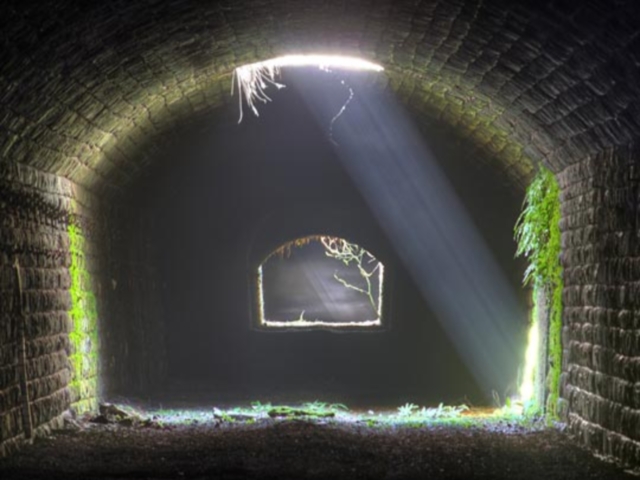 The vision behind the White Peak Loop is to create extensions to the Monsal trail from Bakewell to Matlock
and phase 2 will extend the trail from Buxton to the start of the Tissington trail. The County Council,
together with their consultants URS Infrastructure & Environment UK Limited, are currently carrying out
a short consultation about the 7 mile section to extend the Monsal Trail south into Matlock. The route
will follow the dismantled railway line, including re-opening the 945m long tunnel, through the Haddon
Estate. It is intended that the route will include 3 new bridges in the Rowsley area.
The vision behind the White Peak Loop is to create extensions to the Monsal trail from Bakewell to Matlock
and phase 2 will extend the trail from Buxton to the start of the Tissington trail. The County Council,
together with their consultants URS Infrastructure & Environment UK Limited, are currently carrying out
a short consultation about the 7 mile section to extend the Monsal Trail south into Matlock. The route
will follow the dismantled railway line, including re-opening the 945m long tunnel, through the Haddon
Estate. It is intended that the route will include 3 new bridges in the Rowsley area. -
Norbury Manor
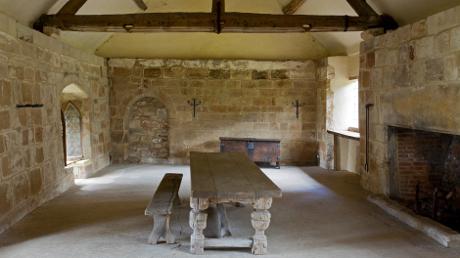 Norbury Manor, was the former residence of the Fitzherbert family. The building has a very rare
example of a medieval hall built on the first floor, once forming part of the private apartments of the
Fitzherbert’s. The only surviving part of the original early medieval hall offers a rare king post,
Tudor door and 17th-century Flemish glass. Now owned by the National Trust, the whole manor is available
to rent, with five bedrooms.
Norbury Manor, was the former residence of the Fitzherbert family. The building has a very rare
example of a medieval hall built on the first floor, once forming part of the private apartments of the
Fitzherbert’s. The only surviving part of the original early medieval hall offers a rare king post,
Tudor door and 17th-century Flemish glass. Now owned by the National Trust, the whole manor is available
to rent, with five bedrooms. -
The JCB Dieselmax
 J.C. Bamford Excavators Limited, are universally known as JCB, they are a British multinational corporation,
with their headquarters in Rocester. JCB produces over 300 types of machines, including diggers, excavators,
tractors and much more, but did you know they built the fastest diesel racer in the World? The JCB Dieselmax
is a diesel-engined car designed specifically for the purpose of breaking the land speed record. As of 2014,
the car holds the World diesel-powered land speed record, having been driven to over 350 miles per
hour.
J.C. Bamford Excavators Limited, are universally known as JCB, they are a British multinational corporation,
with their headquarters in Rocester. JCB produces over 300 types of machines, including diggers, excavators,
tractors and much more, but did you know they built the fastest diesel racer in the World? The JCB Dieselmax
is a diesel-engined car designed specifically for the purpose of breaking the land speed record. As of 2014,
the car holds the World diesel-powered land speed record, having been driven to over 350 miles per
hour. -
Day 3 Gallery
 Why not have
a look at the gallery relating to day 3 of this ride. Click the image or the title.
Why not have
a look at the gallery relating to day 3 of this ride. Click the image or the title. -
Little Haywood protected wall
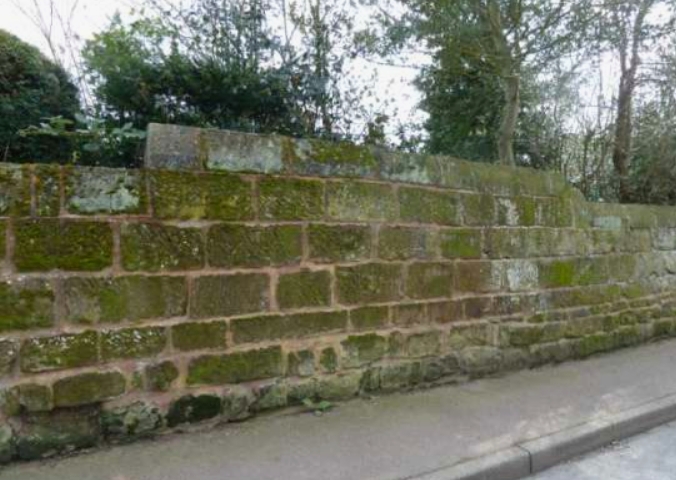 Little Haywood has many listed buildings and rightly so, but there is the wall that runs at the side of a
road, from Little Haywood towards the village of Great Haywood. It was an example of a "make
work wall", built by employees of Earl Talbot at Haywood Manor (no longer standing) during times when there
was little else to do. These walls are now within a conservation area and are protected. Protected
walls- I’ve never heard of it before!
Little Haywood has many listed buildings and rightly so, but there is the wall that runs at the side of a
road, from Little Haywood towards the village of Great Haywood. It was an example of a "make
work wall", built by employees of Earl Talbot at Haywood Manor (no longer standing) during times when there
was little else to do. These walls are now within a conservation area and are protected. Protected
walls- I’ve never heard of it before!

 Built in 1674 by the Earl of Shrewsbury on the sanction of Queen Elizabeth 1st to provide accommodation
for Mary Queen of Scots during her house arrest, the Old Hall is thought to be England’s oldest
hotel. Unusually this hotel was built over a hot spring that is currently beneath the eastern end of
the hotel, this hot spot was an important sacred shrine for Celtic travelers and became a popular bath
for the Roman settlement “Aqua Arnemetia”.
Built in 1674 by the Earl of Shrewsbury on the sanction of Queen Elizabeth 1st to provide accommodation
for Mary Queen of Scots during her house arrest, the Old Hall is thought to be England’s oldest
hotel. Unusually this hotel was built over a hot spring that is currently beneath the eastern end of
the hotel, this hot spot was an important sacred shrine for Celtic travelers and became a popular bath
for the Roman settlement “Aqua Arnemetia”.
 Mary Queen of Scots was executed in 1587, on her last visit to the old hall, she carved a message
on the window in Room 26, “Buston, whose warm waters have made thy name famous, perchance I shall
visit thee no more—Farewell.” Many guests who have visited room 26 have reported the presence of
Mary and believe they feel her while staying in the room. Even creepier is the fact that the
inscription can still be seen in the room.
Mary Queen of Scots was executed in 1587, on her last visit to the old hall, she carved a message
on the window in Room 26, “Buston, whose warm waters have made thy name famous, perchance I shall
visit thee no more—Farewell.” Many guests who have visited room 26 have reported the presence of
Mary and believe they feel her while staying in the room. Even creepier is the fact that the
inscription can still be seen in the room. Litton Mill was opened in 1782 and became notorious for the harsh and abusive treatment of its employees. The owner,
Ellis Needham meted out punishment to the child labourers brought in from London and other big cities to fuel the
wheels of industry. Overall, child labour was crucial to the development of the cotton mills, but there
was very little legal protection for the children. This cruel exploitation caused the deaths of many
kids, some as young as nine or ten, as their graves in Tideswell and Taddington churchyards will
testify. The testimony of one of the children at the mill helped change the law to improve conditions
and ban minors working under a certain age.
Litton Mill was opened in 1782 and became notorious for the harsh and abusive treatment of its employees. The owner,
Ellis Needham meted out punishment to the child labourers brought in from London and other big cities to fuel the
wheels of industry. Overall, child labour was crucial to the development of the cotton mills, but there
was very little legal protection for the children. This cruel exploitation caused the deaths of many
kids, some as young as nine or ten, as their graves in Tideswell and Taddington churchyards will
testify. The testimony of one of the children at the mill helped change the law to improve conditions
and ban minors working under a certain age.  Engineers may have designed the railways, but it was left to vast gangs of navvies to build them. The
word ‘navvy’ came from the ‘navigators’ who built the first ‘navigation canals’ in the eighteenth
century. They lived by the rail line that they were building in so-called shanty towns. Huts could
accommodate twenty men and they paid one and a half pennies for a bed for the night. Those who slept on
the floor paid a lot less. Five nights of floor sleeping cost one penny.
Engineers may have designed the railways, but it was left to vast gangs of navvies to build them. The
word ‘navvy’ came from the ‘navigators’ who built the first ‘navigation canals’ in the eighteenth
century. They lived by the rail line that they were building in so-called shanty towns. Huts could
accommodate twenty men and they paid one and a half pennies for a bed for the night. Those who slept on
the floor paid a lot less. Five nights of floor sleeping cost one penny. 



